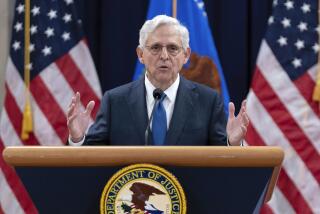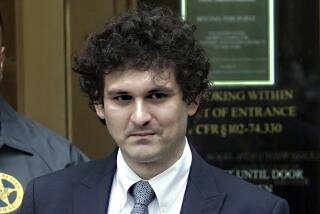Clausen Praised, Criticized for BofA Role
- Share via
On the Saturday of his wedding in 1950, one year after joining Bank of America, a youthful and ambitious A.W. (Tom) Clausen is said to have worked two hours late just to track down a $10 bookkeeping error.
Whether that story is true or not, there was never any doubt that Alden Winship Clausen was dedicated and hard-working. Such dedication helped him rise to become president and chief executive of BankAmerica Corp. and its Bank of America subsidiary in 1970--a position he held for 11 years, during which the assets and earnings of what was then the nation’s largest bank more than quadrupled.
The dedication and character are apparently among the traits that are expected to prompt BankAmerica’s directors to bring Clausen back as chief executive in what could become one of the most notable “comebacks” in U.S. banking history.
Clausen admirers say the 63-year-old banker would bring a stabilizing force to a company racked with declining investor confidence and low employee morale, stemming from about $1 billion in losses during the past year under the leadership of Samuel H. Armacost, who Friday announced his resignation as chief executive and president.
‘Impeccable Character’
“If Tom Clausen has any overwhelming trait, it’s the impeccability of his character,” one former BankAmerica executive, who worked extensively with Clausen and knows him well, said Friday. “The BankAmerica board would like to have that impeccable character” as it proceeds with its recovery and a decision on whether to accept a pending $2.8-billion takeover bid from First Interstate Bancorp, the former executive said.
But just as Clausen receives plaudits for his dedication and character, he also receives widespread blame for much of what ails BankAmerica today. And that stigma, critics said Friday, makes him a bad choice--if even on an interim basis--for leading the bank through perhaps the most difficult period in its 82-year history.
“Investors would react very negatively if he’s named as permanent CEO,” said Dan B. Williams, a banking analyst at Sutro & Co. in San Francisco. “It’s clear that a lot of the things the bank did in the 1970s (under Clausen), the bank has been paying for ever since.”
Critics--including many current BankAmerica executives who now might regret their statements about Clausen--have said that Clausen achieved his triumphs of the 1970s largely by short-changing the future.
Record Income Growth
During the last five years of Clausen’s reign, net income growth at BankAmerica averaged 18.7% a year, a record no other bank among the nation’s 10 largest came close to matching. But critics have accused Clausen of overstating those earnings through such accounting gimmicks as booking loan fees up front, instead of over the life of the loan.
Clausen also failed to invest enough on new technologies, such as automated teller machines, critics said. In 1981, the bank had only 78 teller machines in California, whereas today it has well over 1,000, more than any other bank in the country. And customer service is said to have declined sharply in the late 1970s.
Critics have also said Clausen was slow to recognize the consequences of banking deregulation and the need to develop new products and services to compete with such financial services giants as American Express and Merrill Lynch, that were making inroads into traditional banking markets.
Clausen also was responsible for the bank’s big push in the late 1970s into international lending, an area that now fills the bank’s portfolio of bad loans, critics said. And a similar rush into fixed-rate mortgage lending backfired when interest rates soared in the early 1980s.
Clausen also has been criticized as domineering and bureaucratic, failing to promote and reward promising managers and surrounding himself with “yes” men. He resisted hiring outsiders, seldom fired non-performers and his effort to decentralize management led to loose lending procedures and poor oversight. But while management was decentralized, major decisions were still made by Clausen, critics said.
‘Strong Point of View’
“Tom was a very autocratic person with a very strong point of view,” BankAmerica Vice Chairman James B. Wiesler said in a 1984 interview with The Times.
Critics add that Clausen’s five-year tenure as president of the World Bank, a post he took in 1981 after leaving BankAmerica, was lacking in notable achievements. Many observers blame the World Bank’s declining influence during the period on Clausen’s lack of charisma and reluctance to fight the Reagan Administration for more funds and a more active role in the world debt crisis.
But Clausen, who refused to comment Friday about his expected appointment at BankAmerica, has staunchly denied that he deserves being the patsy for BankAmerica’s current woes.
Clausen Defends Work
“I’d say my record is there. It’s very visible. I rest my case,” Clausen said in a January interview with The Times, breaking his then five-year refusal to comment on his BankAmerica tenure. “The managers of the bank now were managers when I was there,” Clausen continued in that interview. “They shared in those decisions.”
Indeed, critics acknowledge, Armacost and other top executives also made many of the bad international, real estate and agricultural loans that haunt the bank today.
Whoever deserves the blame, Clausen now may have a golden opportunity to turn the bank around--and salvage his reputation.
Also, the job will get Clausen active again. Since he left the World Bank “he hasn’t been doing anything. He’s a little lonely and a lot bored,” a former associate of Clausen’s at the World Bank said Friday.
“It’s a chance for him to gain back a little face,” a former BankAmerica executive said Friday.
More to Read
Inside the business of entertainment
The Wide Shot brings you news, analysis and insights on everything from streaming wars to production — and what it all means for the future.
You may occasionally receive promotional content from the Los Angeles Times.










